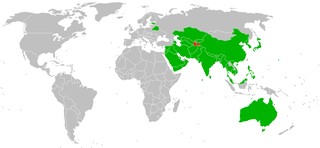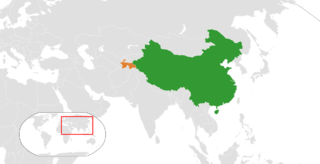
Tajikistan competed at the 2011 World Aquatics Championships in Shanghai, China between July 16 and 31, 2011.

Tajikistan competed at the 2011 World Aquatics Championships in Shanghai, China between July 16 and 31, 2011.
Tajikistan qualified 3 swimmers. [1]
| Athlete | Event | Heats | Semifinals | Final | |||
|---|---|---|---|---|---|---|---|
| Time | Rank | Time | Rank | Time | Rank | ||
| Alisher Chingizov | Men's 50m Freestyle | 29.05 | 102 | did not advance | |||
| Men's 50m Butterfly | DNS | did not advance | |||||
| Ruslan Oliftaev | Men's 50m Breaststroke | 37.56 | 45 | did not advance | |||
| Men's 100m Breaststroke | 1:25.82 | 80 | did not advance | ||||
| Athlete | Event | Heats | Semifinals | Final | |||
|---|---|---|---|---|---|---|---|
| Time | Rank | Time | Rank | Time | Rank | ||
| Katerina Izmailova | Women's 50m Freestyle | 31.38 | 67 | did not advance | |||
| Women's 100m Freestyle | 1:11.56 | 74 | did not advance | ||||

Tajikistan, officially the Republic of Tajikistan, is a landlocked country in Central Asia. Dushanbe is the capital and most populous city. Tajikistan is bordered by Afghanistan to the south, Uzbekistan to the west, Kyrgyzstan to the north, and China to the east. It is separated from Pakistan by Afghanistan's Wakhan Corridor. It has a population of over 10.7 million people.

Tajiks is the name of various Persian-speaking Eastern Iranian groups of people native to Central Asia, living primarily in Afghanistan, Tajikistan, and Uzbekistan. Even though the term Tajik does not refer to a cohesive cross-national ethnic group, Tajiks are the largest ethnicity in Tajikistan, and the second-largest in Afghanistan and Uzbekistan. More Tajiks live in Afghanistan than Tajikistan. They speak varieties of Persian, a Western Iranian language. In Tajikistan, since the 1939 Soviet census, its small Pamiri and Yaghnobi ethnic groups are included as Tajiks. In China, the term is used to refer to its Pamiri ethnic groups, the Tajiks of Xinjiang, who speak the Eastern Iranian Pamiri languages. In Afghanistan, the Pamiris are counted as a separate ethnic group.

Dushanbe is the capital and largest city of Tajikistan. As of March 2024, Dushanbe had a population of 1,564,700, with this population being largely Tajik. Until 1929, the city was known in Russian as Dyushambe, and from 1929 to 1961 as Stalinabad, after Joseph Stalin. Dushanbe is located in the Gissar Valley, bounded by the Gissar Range in the north and east and the Babatag, Aktau, Rangontau and Karatau mountains in the south, and has an elevation of 750–930 m. The city is divided into four districts: Ismail Samani, Avicenna, Ferdowsi, and Shah Mansur.

Emomali Rahmon is a Tajik politician who has served as the President of Tajikistan since 1994, having previously led the country as Chairman of the Supreme Assembly from 1992 to 1994.

The national flag of Tajikistan was adopted in November 1992, replacing the flag of the Tajik Soviet Socialist Republic of 1953. The flag features Iranian colors in a horizontal tricolor of red, white, and green, with a yellow crown surmounted by an arc of seven stars at the centre. It has a width ratio of 2:3:2. The tricolor preserves the choice of colors in the former Tajik Soviet flag, as well as the 1:2 proportions.

Gorno-Badakhshan, officially the Badakhshan Mountainous Autonomous Region, is an autonomous region in eastern Tajikistan, in the Pamir Mountains. It makes up nearly forty-five percent of the country's land area but only two percent of its population.

Tajikistan competed at the 2004 Summer Olympics in Athens, Greece, from 13 to 29 August 2004.

The Tajikistan national football team represents Tajikistan in international football and is controlled by the Tajikistan Football Federation, the governing body for football in Tajikistan. Tajikistan's home ground is the Pamir Stadium in Dushanbe.

Sunni Islam is, by far, the most widely practiced religion in Tajikistan. Sunni Islam of the Hanafi school is the recognized religious tradition of Tajikistan since 2009. According to a 2009 U.S. State Department release, the population of Tajikistan is 98% Muslim,, with some Sufi orders.

The Tajikistani Civil War, also known as the Tajik Civil War, began in May 1992 and ended in June 1997. Regional groups from the Garm and Gorno-Badakhshan regions of Tajikistan rose up against the newly formed government of President Rahmon Nabiyev, which was dominated by people from the Khujand and Kulob regions. The rebel groups were led by a combination of liberal democratic reformers and Islamists, who would later organize under the banner of the United Tajik Opposition. The government was supported by Russian military and border guards.

The Ligai Olii Tojikiston or Tajikistan Higher League is the top division of professional football in Tajikistan. It is part of the Tajikistan Football League Organization and Tajikistan Football Federation.

As of 2020, the regions of Tajikistan are subdivided into 47 districts, not including 4 districts belonging to the capital city Dushanbe, and 18 cities of regional subordination. Before ca. 2017, there were 58 districts. The districts are further subdivided into municipal units: either as urban municipalities called either as cities or towns, or as rural municipalities called jamoats, which in turn are further subdivided into villages.

Iran–Tajikistan relations refer to the bilateral relations between Iran and Tajikistan. Since the collapse of the Soviet Union, the two countries have naturally enjoyed a close and strong relationship with the two often being described as "one spirit in two bodies" by the ex-president of Iran Mahmoud Ahmadinejad due to both being Persian-speaking and Iranic countries.

This page shows the Tajikistan national football team's results in International Matches, as recognized by FIFA:

Tajikistan competed at the 2012 Summer Olympics in London, from 27 July to 12 August 2012. This was the nation's fifth consecutive appearance at the Olympics. The National Olympic Committee of the Republic of Tajikistan sent the nation's largest delegation to the Games. A total of 16 athletes, 13 men and 3 women, competed in 7 sports. Six of these athletes had competed in Beijing, including judoka Rasul Boqiev and freestyle wrestler Yusup Abdusalomov, who both won Tajikistan's first ever Olympic medals.

Visitors to Tajikistan must obtain a visa unless they are citizens of one of the visa-exempt countries, or citizens who may obtain a visa on arrival, or citizens eligible for an e-Visa.

The People's Republic of China and the Republic of Tajikistan have friendly relations characterized by bilateral and multilateral collaboration.
Tajik Canadians are Canadian citizens of Tajik descent. According to the 2011 Census there were 2,400 Canadians who claimed Tajik ancestry. Presently in the province of Quebec there are living around 500 families of Tajiks from Tajikistan, Afghanistan, Uzbekistan, Russia, Israel, etc. They reside in Montreal, Quebec City, Sherbrooke and Granby cities. More than 500 Tajik families are living in the Toronto area. Around 200 Tajik families are living in the Calgary area and the city of Vancouver.
This is a list of official football games played by Syria national football team between 2010 and 2019.